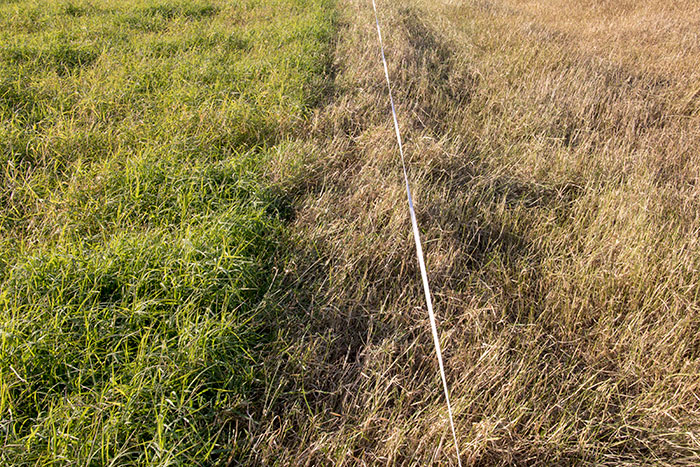Strip-graze your stockpiled forages |
| By Kassidy Buse |
|
|
|
One of the largest expenses for cattle producers is feeding cattle during the winter. When purchasing hay and supplements to accommodate energy needs, the costs add up. According to Ray Hicks, Screven County extension coordinator with the University of Georgia, stockpiling bermudagrass or bahiagrass for winter feeding is a good way to minimize hay and labor costs. “You can expect to get 30 to 60 days of grazing from this practice, but to do this you need to follow a few management steps,” Hicks explains. Hicks says it all starts with a quality product. “A bermudagrass hybrid such as Tifton 85 or Russell works best,” he states. “But you can use bahiagrass; just know your quality and quantity is going to be lower.” Along with a good quality grass, optimal soil fertility is important. Make sure that the soil pH is within 6 to 6.5 and that it is fertilized according to soil test results. Approximately eight weeks before the first killing frost, either cut or graze down the area to prepare for stockpiling. After removing cattle, apply 40 to 50 units of nitrogen per acre. “Be patient because growth of bermudagrass and bahiagrass is slow during the cooler months,” Hicks advises. He adds that around 40 to 60 days after the last fertilization is when you can start grazing the stockpiled forage, but timing is highly dependent on the amount of rainfall the area receives. To get the most out of the stockpiled forage, Hicks recommends utilizing strip grazing. Strip grazing requires less labor than timed grazing where cows are allowed to graze for a period of time before being moved, but it still preserves forage by preventing cattle from trampling the entire area. “This system works well when regrowth of forages will likely not occur, like stockpiled dormant forages,” he clarifies. Hicks also advises to look where your water source is and make sure it works into your grazing plan. Test stockpiled forage to determine the energy and protein levels. “You may need to supplement according to the class of cattle that you are running on this forage,” Hicks explains. While strip grazing stockpiled forages does take more management, it can save time and labor when compared to feeding baled hay.  Kassidy Buse Kassidy Buse was the 2018 Hay & Forage Grower summer editorial intern. She is from Bridgewater, S.D., and recently graduated from Iowa State University with a degree in animal science. Buse is currently attending the University of Nebraska-Lincoln pursuing a master’s degree in ruminant nutrition. |

